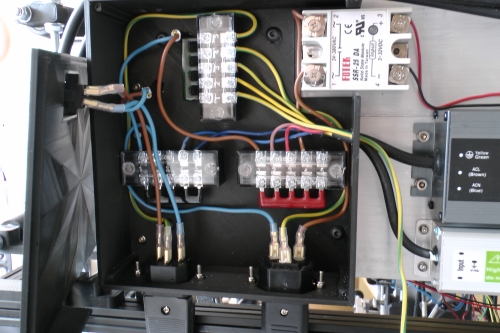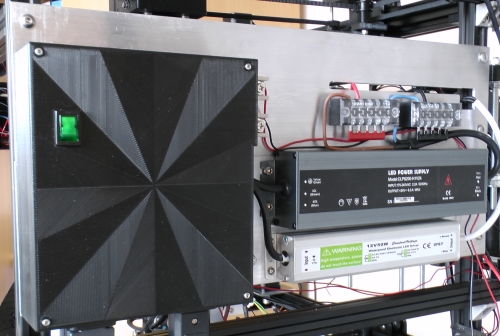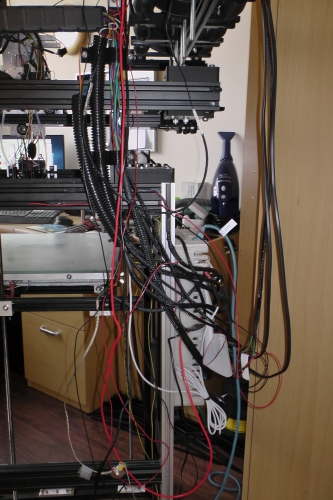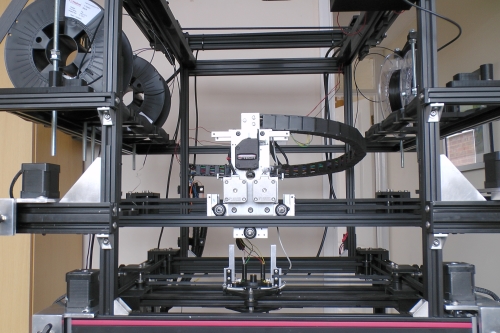Duet 3 release date
-
Hmm ... Well then let's surprise ourselves.
Do you think the expansion board for the network is offered directly by Duet, or do you have to "tinker" yourself? -
Time will tell. I just don't see the problem - the customers why buy just the Duet board are likely comfortable with building, wiring and configuring a 3d printer from scratch ... adding a Raspberry Pi isn't really increasing the complexity by much.
-
This is the statement I was referring to earlier, which indicates that a standalone Duet board will still be available though with limited software updates.
We expect Duet 2 to continue to be mainstream for most applications and we will continue to make minor improvements to the Duet 2 series.
-
I think the detachable raspberry (-like?) SBC is a very good way to really future-proof the product.
For example if and when the computing capacity becomes a limit for the ever smarter firmware, you just swap out the SBC to a later model, more powerful one.
Also with the addition of CAN capability you will be able to add stepper ICs which will be released in the years to come.In the hw developer's place I probably would have contemplated taking this even one step further, and produce a "master" board which is only a bridge between the CAN based expansion boards and the attached SBC witout any other function, and put all the steppers, fan- and heater outputs, io-s, etc. onto expansion boards, which could be either snapped on, or can cabled to the main board (users choice, same hw).
This architecture would also separate the logic from the execution, therefore:
- make a more fine-grade price control possible
- A catastrophic short would only kill the affected expansion board not the whole system
- eliminate the need to cable everything to the center board (I know that it's possible to not use those connectors, and just connect everything to the expansion boards, but still it would feel bad not to use them once they are there
 )
)
Anyone agree or am I just mad?

-
@zapta yeah, Duet 2 will benefit from the version 3 RepRapFirmware in any case, and the Duet 2 hardware is more than capable to handle the (relatively) small DIY and consumer 3D priners for the foreseeable future.
But to get back on track, they said "maybe" production boards for the TCT show, so thats september-ish isn't it?
-
In the absence of anyone from Duet stepping in here, I'll tell you what little I know, on the basis that the intention is for my printer to be on the Duet stand at the TCT show, with Gen 3 hardware. Quite what version of hardware that will be is still a bit up in the air. I doubt if it will be final production but maybe it will. At this moment in time, I don't have any gen 3 hardware at all. I don't know any secrets so I can't give any away.
My take on what @Zapta said about this quote "We expect Duet 2 to continue to be mainstream for most applications and we will continue to make minor improvements to the Duet 2 series. is exactly as it says. i.e the Duet 2 will continue to be the mainstream product and they will continue to make minor improvements to the hardware. But as it will continue to be the mainstream product then I'd expect software updates will not be limited as @Zapta thought. It will after all continue to be the mainstream product, so I don't see any reason why software upodates would therefore be limited.
Duet 3 will indeed also need a RPi. There are both pros and cons to this. I foresee the largest "con" as being the boot up time. Unlike Duet 2 where the printer is ready to run almost instantly after power up, there will be a delay of nn seconds while the RPi boots. I don't know enough about what the RPi will be doing to make any sort of informed comment about the "pros".
Duet 3 will consist of a main board with 6 stepper drivers and a number of in/out connections. At the moment, expansion boards will have 3 additional stepper drivers each plus a variety of in/out connections. Additional expansion boards can be "daisy chained" giving the capacity for many more steppers. Communication between the boards will be via Can Bus (but I can't say which variety).
I believe the stepper drivers will be able to handle larger motors.
I would expect gen 3 will be more expensive, especially when you factor in the price of an RPI. The main board will have 6 drivers instead of the Duet 2's 5 and all boards will have a Can Bus in and out which I guess adds cost.
I really can't say any more because I really don't know any more. Oh, I can tell you dimensions of the expansion boards because I've been given those in order to be able to start planning how and where I can fit the hardware.
The benefits for me personally, are that I'll be able to run 13 plus steppers which I need for my 7 axis, 6 extruder beast. But most of all, as readers of my blog will know, I have my 5 (soon to be 6) extruders on a separate CoreXY gantry which runs above the main hot end gantry (so it's coreXYUV). This means that I have a huge cable chain connected to that gantry with 40 plus conductors running through it. Gen 3 will allow me to fit two expansion boards on that gantry along with the 6 extruders so I'll only need power and data in and out, and maybe one or two additional conductors for LED lights.
The Duet guys seem to be confident that all will be well for the TCT show. Personally, I'm a little nervous because I've yet to see any hardware and I have to completely re-wire my machine when it does arrive. On the other hand, I am now retired so I have more spare time. I'll give it my best shot...........
-
@deckingman said in Duet 3 release date:
I foresee the largest "con" as being the boot up time.
I don't think this will be the case, as RPI is a computer without an OS, the OS you have to provide (usually a variant of linux which boots slownly by comparison to RTOS), If you load the reprap RTOS on it then it will be as fast as (actually faster because the more powerful cpu) the current duet2. Please correct me if I'm mistaken.
-
@denke Looks like it will run duet3d software on top of linux. See here for prototype details, although this may not all apply to the final product: https://duet3d.dozuki.com/Wiki/Duet_3_prototype_guide_for_OEMs.
I imagine that it won't be necessary to restart/reset the raspi frequently. Boot times on a stripped down raspi install are only a few seconds in any case.
-
@denke said in Duet 3 release date:
If you load the reprap RTOS on it then it will be as fast as (actually faster because the more powerful cpu) the current duet2. Please correct me if I'm mistaken.
The RTOS that forms a chunk of RepRapFirmware is a really stripped down OS that I believe provides threading capability to microprocessors. I also think it is aimed at the Sam ATMEL processor that runs in the Duets.
CAN was available on the old Arduino Due. I wonder if there is an opening for people who want the practicality of local stepper control but don't need the real time processing clout requied for 5+ channel mixing. In other words a version of RepRapFirmware 3 configured to run all axis through the CAN bus. I'd be interested to hear if there were performance reasons for that architecture not being used rather than the cost to set up your standard machine.
Edit: I'm not suggesting we cram RepRapFirmware 3 onto the Due, more like the Ada Fruit Grand Central which I believe is Due format but with a very simialr processor to the Duet 2 boards.
-
@deckingman surely you can "cheat" and get started on RRF3 with the Duet 2 hardware, and even start the re-wiring before you get the Duet 3 hardware? Trade off would be longer downtime, but maybe worth it?
-
@bearer said in Duet 3 release date:
@deckingman surely you can "cheat" and get started on RRF3 with the Duet 2 hardware, and even start the re-wiring before you get the Duet 3 hardware? Trade off would be longer downtime, but maybe worth it?
This is getting a bit off topic but ...........
I'm doing what I can. One thing that's a bit of head ache for me is that in order to get the printer through the door of my study, I have to break it down into two sections. Mechanically, that's easy to do - just 4 bolts. But as things were until a couple of days ago, there were a lot of cables running between those two sections. That was a bit of pain the last time I took my printer to the TCT show so in order to mitigate that, I've moved all the mains wiring, PSUs, SSR, etc. That was all at the bottom of the printer. Now it's on a new aluminium plate fixed to the top section, closer to where 3 of the boards will be fitted.
Like this


But I need to keep the printer running in order to make new cases when the the new boards arrive. So the rest of the wiring now looks like this

The new extruder gantry to take 6 extruders and two expansion boards is finished (just hope the boards fit).

Like I said, this is getting way off topic and I shouldn't really be posting these pictures in this thread. So, if you really want to know how things are progressing, take a look at my blog (link in my signature). As well as Duet 3, I've done few other upgrade and have a couple more planned before the show.
-
Hi any updates on a round two of duet 3 sales? I'm only waiting on this last piece before I can get printing

-
This post is deleted! -
@elmoret yes that does help! Thanks for the heads-up!
-
We're currently planning to open a pre order for the next batch next week. Delivery is expected to be in November.
-
Just to confirm, we will be releasing the next batch to preorder the back end of next week, targeting a delivery schedule of November. This will be a larger batch and should see the Mainboard transition to a "normally in stock" product.
I realise that the slow ramp to general availability is frustrating people who want to get their hands on one ASAP. We are ensuring we learn from the ramp up on Duet 2 and have things "behind the scenes", like Automated Test Equipment, in a good place.
-
@T3P3Tony ATE?
-
@DocTrucker edited
-
@T3P3Tony Cheers!
-
@T3P3Tony so after the New Years you will work on major updates to the Duet 2 line of boards?